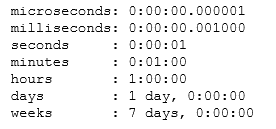


We add this object to original datetime object, to obtain final datetime object. Then we obtain an interval object (relativedelta/timedelta/dateoffset). First we convert a datetime string to datetime object using strptime function. In this article, we have looked at 3 different utilities to add time to datetime value. from datetime import datetimeįinal_time = given_time + pd.DateOffset(minutes=n) Here also we convert datetime string to datetime object using strptime function, obtain dateoffset object from interval value, and add it to the datetime object to obtain final datetime.
#Python datetime minus minutes code#
Here is the code to add minutes to datetime value. It is used to increment or decrement given datetime value. It provides DateOffset class which is similar to timedelta and relativedelta objects used above. You can also use python pandas to add time interval to datetime. We simply add this relativedelta object to datetime object to obtain final datetime object, which we convert to string using strftime function. Here also, we convert datetime string to datetime object using strptime function, use relativedelta function to obtain relativedelta object from time interval. from datetime import datetimeįrom dateutil.relativedelta import relativedeltaįinal_time = given_time + relativedelta(minutes=n) Here too, we will obtain datetime object from datetime string, get relativedelta object from interval value, and then add it to datetime object to obtain final value. It contains relativedelta class that represents datetime interval. We use strftime function to get final_time_str string from datetime object.ĭateutil is a library of functions and utilities that help you manipulate date, time and datetime values. We obtain a timedelta object from 15 minutes, and add it to the datetime object, to obtain final datetime object. We obtain the datetime object given_time from string using strptime function. Then we define our starting time time_str and date format date_format_str. In the above code, we first import datetime and timedelta classes. Print('Final Time as string object: ', final_time_str) # Convert datetime object to string in specific formatįinal_time_str = final_time.strftime('%d/%m/%Y %H:%M:%S.%f') Print('Final Time (15 minutes after given time ): ', final_time) Given_time = datetime.strptime(time_str, date_format_str)įinal_time = given_time + timedelta(minutes=n) # create datetime object from timestamp string Finally, we convert the datetime object back to string, which has the same format as the starting datetime string. Then we will add 15 minutes to this datetime object.

First, we will convert it into a datetime object. Let us say you have a datetime string to start with. For our example, we will add 15 minutes to our datetime value. Python comes with datetime module that allows you to work with date, datetime, timedelta and time objects. Here are the different ways to add time to date or datetime values in python – using timedelta, pandas and relativedelta. In this article, we will look at 3 different ways to add minutes to datetime in python. There are multiple ways to solve this problem. Sometimes you may need to add minutes or time to datetime in Python.

import datetime datetime (year, month, day, hour, minute. Here are the different ways to add time to date or datetime values in python using timedelta, pandas and relativedelta. Example 1: The following program takes two datetime objects and finds the difference between them in minutes. MyDateTime = datetime.Python is a powerful programming language that allows you to perform wide range of tasks. To find the difference between two dates in form of minutes, the attribute seconds of timedelta object can be used which can be further divided by 60 to convert to minutes. So let's see the below example:ĬurrentTimeDate = datetime.now() - timedelta(hours=1)ĬurrentTime = currentTimeDate.strftime('%H:%M:%S') I am use datetime and time module to get current date minus hour.
#Python datetime minus minutes how to#
Here I will give two example for how to get current date substract hour in python. This article will give you example of get current date then minus a hour in python. The datetime module is supplies classes for manipulating dates and times. We will learn get current date minus a hour using python. I am going to show you python get current date sub hour. Now let's see example of how to get current date minus 1 hour in python.


 0 kommentar(er)
0 kommentar(er)
